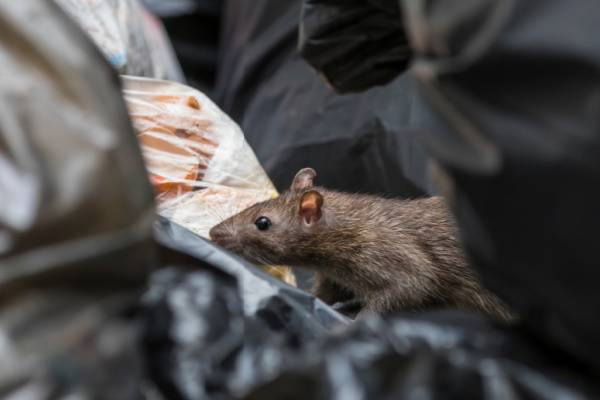What are Roof Rats?
Found worldwide, the roof rat is common across the US, and even more prevalent in coastal states and seaports, according to the Washington Department of Fish and Wildlife.
Also known as the black rat or ship rat, its body is long and thin, and coat is brown to black on top with gray, white, or black undersides. They have large ears, and a long, thin, scaly tail. Generally 6-8 inches in length, the tail adds another 6-8 inches.
Roof rats are nocturnal. They perform foraging and other activities at night, and return to their nest during the day.
Roof Rat Removal Services Near You
Get a Croach® pest exterminator near:
- Seattle (including Mukilteo, Sumner, Kirkland, Tacoma, Mount Vernon) and Tri-Cities, Washington.
- Spokane, Post Falls, Kooskia, Lewiston, and Boise, Idaho.
- Portland, Beaverton, Oregon.
- Denver, Aurora, Colorado.
- Columbia and Greenville, South Carolina.
- Charlotte, North Carolina.
- Salt Lake City, Sandy, Utah.
Where Do They Nest?
Roof rats live in colonies and prefer high structure such as attics and rafters. However, they are adept at living anywhere they find suitable locations near food and water.
So you'll also find them nesting under and inside structures, in vine-covered trees, or in piles of wood or debris.
What Are the Signs of an Infestation?
Since roof rats are nocturnal, spotting them during the day running on tree limbs, walls, or power lines is a strong indicator you have a serious rat infestation.
Other facts that indicate rats include:
- Sounds of movement, gnawing or scratching in the walls, ceiling, or attic.
- Gnaw marks on hard surfaces such as the roof or eaves.
- Damaged electrical wiring.
- Hollowed-out fruit on fruit trees.
- Nervous or unsettled pets in your home.
- Grease trails left by their hair.
- Disturbance to insulation material.
- The presence of fecal droppings and urine.
Are Roof Rats Dangerous or Aggressive?
Yes! Like many other rodents, roof rats may react aggressively when threatened and bite in self-defense. Their presence in or around your home poses many serious health risks. Rats were (and continue to be) the known carrier of the bubonic plague. Not only do they carry disease, but they also spread diseases via ticks, fleas, mites, urine, droppings, and hair. Rodents additionally cause food poisoning by contaminating foodstuff or food preparation surfaces.
Roof rats can expose humans to serious disease and bacteria including:
- Plague
- Rat-bite fever
- Salmonellosis
- Hantavirus
- Seoul virus
- Infectious jaundice
- Typhus
- And more
These diseases are spread mostly through the rat's hair, urine, droppings, saliva, and dust created by them as well as through the contamination of food and cookware. Great care should be taken to avoid contact. Always wear protective clothing and masks when cleaning their droppings.
Damage Caused by Roof Rats
A roof rat infestation can lead to serious damage to structures and belongings. Like all rodents, they have front incisors that continuously grow and so must be worn down by gnawing on hard surfaces which can include wood studs, headers, roof trusses, floor joists, soft concrete, drywall, and sheetrock. Commonly, they chew holes in your soffit and eaves to gain access to attic spaces. They also gnaw through electrical wiring, posing a serious fire hazard.
Damage caused by rodents generally are not covered by standard homeowners' insurance policies.
Roof Rats Attract Predators
Roof rats have many predators, so their presence will attract them, and any additional issues that come with increased animal presence such as, risk to other pets, bites, and other hazards.

Rat predators include:
- snakes
- birds of prey
- dogs
- coyotes
- cats
- other rats
Why is it So Hard to Get Rid of Them?
Since they are wonderful at climbing, roof rats can generally escape to higher ground, well out of reach from human intervention strategies. Another reason is that they breed more prolifically than common control measures can eradicate. Female rats reach sexual maturity at 2-5 months and can have three to 12 litters per year with each litter having 4-22 young. DIY solutions are largely ineffective, do not address the root of infestation, and pose risks to users.
Dangers of DIY Rat Removal
Trying to handle a rat infestation on your own can expose you to diseases from rat droppings and urine. You also may be endangered by touching or breathing dangerous extermination chemicals. During your DIY rat removal, your own pets may become poisoned by lethal rat toxins.
Additionally, you may waste time and money on counterproductive 'solutions' that may make the problem worse!
How Do You Get Rid of Roof Rats?
Roof rats are difficult to exterminate without the help of professional rodent control specialists. Removing the current infestation is simply not enough.
The CDC recommends an Integrated Pest Management (IPM) approach, such as used by Croach® Pest Control.
Croach® Pest Control focuses on human and pet safety while using a highly effective ecosystem-based strategy for the long-term prevention of pests and the damage they cause. This strategy uses a combination of techniques that include:
- Pest species identification
- Assessment
- Biological control
- Mechanical and physical controls
- Habitat manipulation
- Exclusion
- Chemical control
- Regular and ongoing treatment
Roof rats are persistent, so we stay vigilant. We use a proactive method of return visits to ensure rodents stay away for good. Regular visits keep rats running, which is why Croach® is one of the top-ranked pest control companies! If you have questions about pest control, call us at (855) 488-7378 or contact us for a FREE INSPECTION.
Free Pest Inspection


